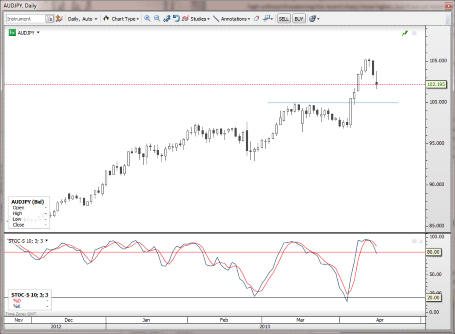A massive sell-off in gold on the back of Friday’s already large drop and other developments saw a wild Asian session for AUD and JPY, turning the tables against recent momentum trades. Interesting week awaits.
Precious metals have come completely unglued since Friday saw the break of longstanding support in the gold market at around 1530. Gold sold off as deeply as the low 1400’s overnight and finally shook AUD and the other commodity currencies out of their complacency, sending AUDUSD back through the 1.0500 support/former resistance and seeing NZDUSD continuing its spectacular reversal off its bizarre, climax rally last week.
The fact that these moves are happening in the gold market during the entire anticipation of Abenomics and then despite the Abenomics-compliant Kuroda managing to exceed market expectations with his big move at his first BoJ meeting is remarkable and suggests that positioning must have become incredibly skewed and that weak hands are getting shaken out of the 10-year bull market in gold as perhaps has not been seen since the general panic deleveraging that followed the Lehman bankruptcy back in the fall of 2008. This has to have considerable implications for FX – the commodity currencies could continue to experience considerable further weakness in the near term should this continue – particularly AUD and NZD as many have already sold the loonie, though its jump higher on Friday and especially today after the brief false break of 1.0100 last week is also technically significant.
The JPY also tried to strengthen a bit overnight, and had a look at the psychologically interesting 97.50 area before trying to rally again. There’s still some room for the pair to move lower toward the old 96.75 high without threatening the recent sharp move higher, but if we cut much below there and especially below 95.00 or so, we are likely to see a brutal further consolidation lower still as the most leveraged short-term players are squeezed out of their positions. The non-USD JPY crosses will be the high beta ones, particularly the likes of AUDJPY and NZDJPY. Be very careful on that account.
Chart: AUDJPY
AUDJPY has been quite a mover on all of the moves in JGB’s and Asian asset markets on the developments in gold and weaker than expected Chinese data. If we are going to see an ongoing correction in JPY crosses from here, expect AUDJPY to be at the epicenter of the action and to be the highest beta of the G7/JPY crosses. AUD/JPY" title="AUD/JPY" width="455" height="334">
AUD/JPY" title="AUD/JPY" width="455" height="334">
Looking ahead
Again, the colossal surge in metals volatility coming at against the backdrop of the BoJ money printing theme (one should always be particularly cautious when the fundamentals scream one thing and the markets not only don’t respond, but move brutally in the opposite direction) and the scary moves in the JGB market (another big sell-off overnight) suggest that we could get volatility contagion across markets that could test a number of recent trends – particularly the trends in asset markets.
Beware the range expansion that is possible in this kind of environment. Markets that persist in moving in one direction for a long period of time with little correction can make for ugly corrections because the speculative flows become too one-way and too leveraged, and the other side of the trade gets “scared away” by having been punished so frequently in trying to fight the market trend.
One key event later this week is the meeting of the G20 finance chiefs in Washington as we await the world’s – and particularly Asia’s – response to the BoJ’s new easing programme. While some Fed officials have expressed approval of the BoJ’s policy, the US treasury has said it will ask Japan not to engage in competitive devaluation of its currency. If we see a fairly widespread rebuke of Japan politically in coming months, it will be interesting to see how the market sorts through the implications – JPY will be likely to weaken long term anyway, but any signs of firm pushback from the international community could mean a rocky road from here for the JPY crosses rather than the one-way move the market has dangerously come to expect.
Watch out again for those RBA minutes up overnight – any wording on the Aussie’s recent strength will be interesting.
US data calendar this week isn’t hugely interesting, but we do have the first regional manufacturing surveys this week (Empire today and Philly Fed on Thursday) and we have the latest housing market data with today’s leading NAHB survey (which is leading and has been declining last couple of months) followed by Housing Starts and Building Permits tomorrow. I’m look for disappointment to settle in some time in the coming few months on the housing front in the US.
Be even more careful out there than the usually careful trade you always ought to be.
Economic Data Highlights
- New Zealand Mar. Performance of Services Index out at 55.4. vs. 55.5 in Feb.
- Australia Feb. Home Loans rose +2.0% MoM vs. +1.5% expected
- China Q1 GDP rose +1.6% QoQ and +7.7% YoY vs. +2.0%/+8.0% expected, respectively and vs. +7.9% YoY in Q4
- China Mar. Industrial Production out at +8.9% YoY vs. +10.1% expected
- China. Mar. Retail Sales out at +12.6% YoY as expected
- Norway Mar. Trade Balance out at +37.7B vs. +33.7B in Feb.
- Euro Zone Feb. Trade Balance (0900)
- US Apr. Empire Manufacturing (1230)
- US Feb. TIC Flows (!300)
- UK BoE’s Bailey to Speak (1315)
- US Apr. NAHB Housing Market Index (1400)
- Australia RBA Meeting Minutes (0130)
